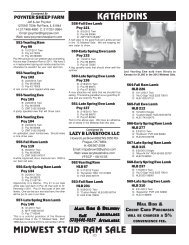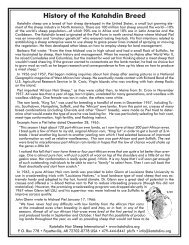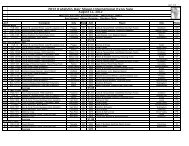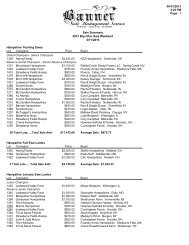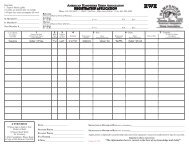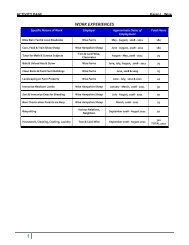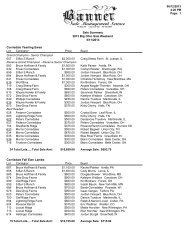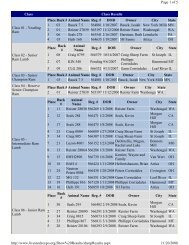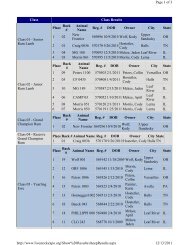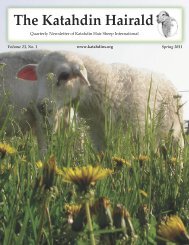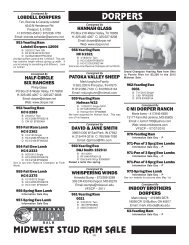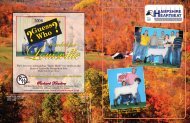Katahdin Breed Characteristics
Katahdin Breed Characteristics
Katahdin Breed Characteristics
You also want an ePaper? Increase the reach of your titles
YUMPU automatically turns print PDFs into web optimized ePapers that Google loves.
<strong>Katahdin</strong> <strong>Breed</strong> <strong>Characteristics</strong><strong>Katahdin</strong>s are hardy, adaptable, low maintenance sheep that produce superior lamb crops and lean,meaty carcasses. They do not produce a fleece and therefore do not require shearing. They are mediumsized and efficient, bred for utility and for production in a variety of management systems. Eweshave exceptional mothering ability and lamb easily; lambs are born vigorous and alert. The breed isideal for pasture lambing and grass/forage-based management systems.Adaptability: <strong>Katahdin</strong>s have demonstrated wide adaptability. They were derived from breeds thatoriginated in the Caribbean and British Islands, and the state of Maine was their original home.In cold weather, they grow a very thick winter coat which then sheds during warm seasons. Theirsmooth hair coat and other adaptive characteristics allow them to tolerate heat and humidity well.<strong>Katahdin</strong>s are also significantly more tolerant of internal and external parasites than wooled sheep,and if managed carefully require only minimal parasite treatment.Temperament: <strong>Katahdin</strong>s are docile so are easily handled. They exhibit moderate flocking instinct.Size: Live weight of a mature ewe in good condition usually ranges from 125 to 185 pounds; a matureram will weigh 180 to 250 pounds. Average birthweight of twins is about 8 pounds.Reproduction: Ewes and rams exhibit early puberty and generally have a long productive life. Matureewes usually have twins, occasionally producing triplets or quadruplets. A well-managed andselected flock should produce a 200% lamb crop. Rams are aggressive breeders, generally fertileyear round, and can settle a large number of ewes in the first cycle of exposure. With selection aflock can consistently lamb throughout the year.Mothering: The <strong>Katahdin</strong> ewe shows a strong, protective mothering instinct, usually lambs withoutassistance, and has ample milk for her lambs. Rejection of lambs is rare.Carcass and Growth: Lambs produce a high quality, well-muscled carcass that is naturally leanand consistently offers a very mild flavor. Lambs are comparable to other medium-sized maternalbreeds in growth and cutability. Lambs are desirable for specialty markets at a variety of ages andweights; wethers are appropriate for conventional North American markets at 95 to 115 pounds.Coat: The hair coat of the <strong>Katahdin</strong> varies in length and texture among individuals and can be anycolor or color combination. It generally consists of coarse outer hair fibers and an undercoat of finewooly fibers that becomes very thick and longer if cold weather sets in and day length decreases.This undercoat and some hair naturally sheds as temperature and day length increase seasonally,leaving a shorter, smooth summer coat. While some uses may be found for the shed fiber, it is generallynot harvested.Crossbreeding: The <strong>Katahdin</strong> can be used in crossbreeding programs. When crossed with woolsheep, the first generation offspring will in most cases have wool fleeces with hair interspersed(the wool from such crosses should be segregated to avoid contaminating higher quality wools). Itusually takes at least 3 generations, depending on the type of wool sheep parentage, to obtain offspringwith a shedding hair coat and other purebred characteristics. <strong>Katahdin</strong> ewes are well-suitedas a base in a terminalsire crossbreeding program to produce market lambs.Market: <strong>Katahdin</strong>s are in demand by:• those who want to raise sheep that do not need shearing• producers who live in areas where wool is a detriment to adaptation or wherewool markets are poor• those who wish to eat or market superior quality lamb with a mild flavor• stock dog trainers• land managers looking for a low-maintenance small ruminant9/09<strong>Katahdin</strong> Hair Sheep International • www.katahdins.orgP. O. Box 778 • Fayetteville, AR 72702-0778 USA • 479-444-8441 ph/fx • info@katahdins.org
<strong>Katahdin</strong> <strong>Breed</strong> StandardGeneral Appearance: A medium-sized sheep with a hair coat and an alert appearance;head erect and legs squarely placed. Rams are distinctly masculine and well-muscled; ewesstrong and feminine.Head: Variety in facial characteristics is expected. Polledness is preferred, but horns and scursare acceptable. Eyes are wide set, and ear carriage is horizontal. Lower teeth meet the dentalpad evenly.Neck: Strong, of medium length: extends straight into the shoulder. A ram’s neck may be coveredby a mane of hair.Shoulders: Blend smoothly into the neck and back; shoulder blades have good width betweenand are level with or slightly higher than the back. Well-developed upper arm musclein rams.Chest: Wide and deep enough to provide ample room for good heart and lung capacity.Slightly less width than hindquarters in females.Back: Strong, smooth, and broad; loin long, wide, deep and well-fleshed.Ribs: Well sprung, wide and deep.Abdomen: Large capacity for consuming forage and carrying lambs (bottom or side lineshould not necessarily be straight).Rump: Wide and well fleshed; rounded appearance; deep in twist.Tail: Length is variable; preferably undocked, except for market lambs.Legs: Medium length and bone in proportion to size. Sound leg structure: properly angled athock, front legs straight, strong pasterns, straight feet free of defect. Muscles of the thigh arethick, with obvious muscularity on the inner and outer thigh, carried down to the shank.Scrotum, Udder: Two large, well-developed and balanced testicles in rams. Two teats onwell-developed, well-balanced udder with good attachment in ewes. Organs free of obviousfunctional defect or disease.Hair Coat: No discrimination is made as to color on any part of the body. The coat shall preferablyconsist of hair rather than wooly fibers, though hair texture will vary. (Refer to the AnimalInspection section of the General Instructions for a description of coat types.)Defects:• Over-or undershot jaw• Very light bone structure• Weak shoulders or back• Cow- or sickle-hocked legs• Weak pasterns or splayed hoofs• Cryptorchidism or monorchidism• Extremely small testicles9/09• Missing or malformed teats<strong>Katahdin</strong> Hair Sheep International • www.katahdins.orgP. O. Box 778 • Fayetteville, AR 72702-0778 USA • 479-444-8441 ph/fx • info@katahdins.org



